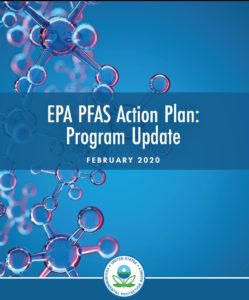EPA Rolls Out Multiple PFAS Actions
 EPA has rolled out multiple PFAS actions in the last month for Clean Water Act (CWA) effluent guidelines; CERCLA (Superfund) hazardous substances designations for PFOA and PFOS; PFAS contamination from fluorinated pesticide containers; PFBS human health toxicity values; and PFOA and PFOS regulatory determinations. Following is more information about EPA’s PFAS effluent guideline actions, CERCLA designations, and fluorinated container contamination, along with links to more information about EPA’s proposals submitted to the Office of Management and Budget (OMB) that are awaiting review.
EPA has rolled out multiple PFAS actions in the last month for Clean Water Act (CWA) effluent guidelines; CERCLA (Superfund) hazardous substances designations for PFOA and PFOS; PFAS contamination from fluorinated pesticide containers; PFBS human health toxicity values; and PFOA and PFOS regulatory determinations. Following is more information about EPA’s PFAS effluent guideline actions, CERCLA designations, and fluorinated container contamination, along with links to more information about EPA’s proposals submitted to the Office of Management and Budget (OMB) that are awaiting review.
EPA’s recent CWA actions are included in the newly published, “Final Effluent Guidelines Program Plan 14,” with the upcoming advance notice of proposed rulemaking to solicit additional information or data about PFAS manufacturers and formulators.
- Plan 14 finalizes the preliminary plan published in October 2019 as part of EPA’s biennial planning requirements for new and revised effluent limitations guidelines to control wastewater discharges after public review and comment. While Plan 14 provides additional information about other point source categories, the areas focused on PFAS include initial analyses from the PFAS Multi-Industry Study. This study reviewed information about where industrial sources are most likely to discharge PFAS into the environment and which PFAS compounds are currently in use. The scope of the study covers the following point source categories: organic chemicals, plastics, synthetic fibers, pulp and paper, textiles, metal finishing, and airports.
- For the upcoming advance notice of proposed rulemaking, EPA will solicit additional information or data about PFAS manufacturers and formulators for the Organic Chemicals, Plastics, and Synthetic Fibers point source category to potentially incorporate national Effluent Limitation Guidelines and Standards (ELGs) for PFAS into National Pollutant Discharge Elimination System (NPDES) permits or other control mechanisms for dischargers.
For more information, visit EPA’s Effluent Guidelines website
EPA’s designation of PFOA and PFOS as CERCLA hazardous substances was submitted to OMB on January 8. CERCLA allows for regulations of hazardous substances that may present a substantial danger to public health or welfare or the environment. This PFOA and PFOS designation would require reporting of releases to state and local authorities that meet or exceed the reportable quantity of one pound in a 24-hour period. This would enable federal, state, tribal and local authorities to collect information regarding the location and extent of PFOA and PFOS releases and determine discretionary response actions (such as litigation against responsible parties to pay for cleanup costs) based on site-specific circumstances. For more information, visit the OMB web page here.
The recent press release from EPA provides information about PFAS leaching from fluorinated high-density polyethylene (HDPE) containers into a mosquito control pesticide product the containers are used to store and transport. EPA coordinated with Massachusetts and the pesticide manufacturer to determine the problem and is undertaking an investigation and assessment of the potential impacts on public health and the environment. The pesticide manufacturer has voluntarily stopped shipping products in the containers and is conducting additional testing. EPA has also issued a request for information from the company that fluorinates the containers under the Toxics Substance Control Act (TSCA). For more information, visit the EPA web page here.
EPA’s PFAS proposals submitted to OMB are listed on the OMB website here and more information is available as follows:
- EPA Office of Research and Development’s Human Health Toxicity Values for PFBS was submitted to OMB on January 11.
- ASDWA’s article about EPA’s PFOA and PFOS Regulatory Determinations that was (now completed) by OMB on January 14.

